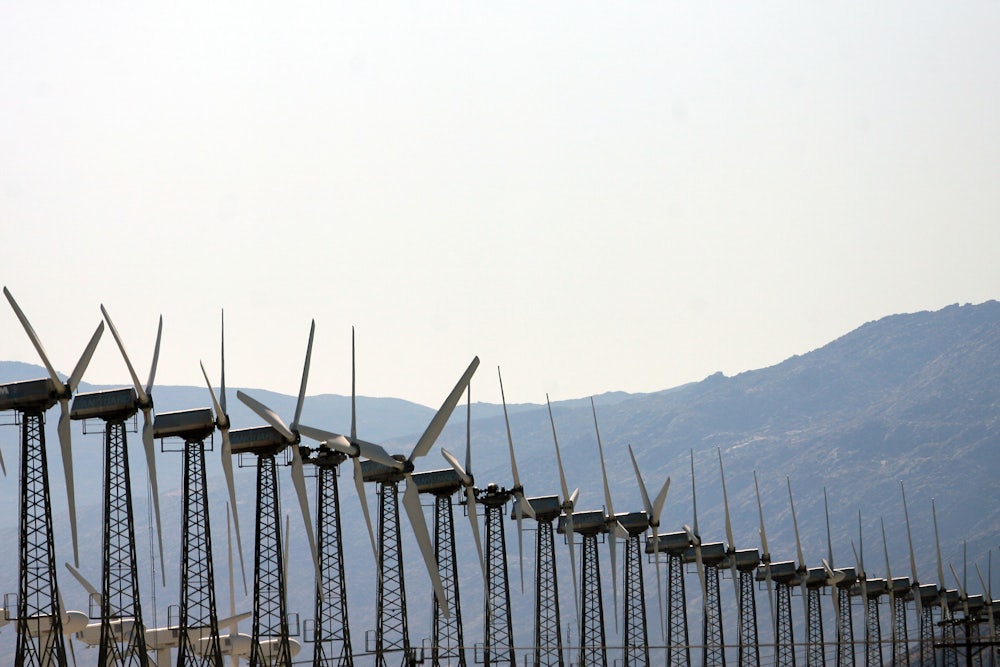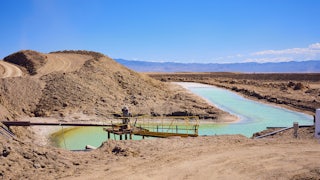Since they were first introduced in the 1970s, tax credits for renewables have helped scale up and dramatically reduce the cost of clean power in the United States. But in recent years they have also created opportunities for a small handful of major investment banks to skim billions off the top, extracting lavish fees and control over clean energy projects as part of deals shrouded in secrecy. Public power providers—who serve nearly a third of retail electricity customers—have trouble accessing clean energy tax credits at all.
The infrastructure package the Biden administration has proposed, and which is currently being debated by lawmakers, presents an opportunity to change that. It could open up incentives to co-ops, municipal utilities, and public power districts while kicking out the rentiers. Or instead, it could apply the current model to a much wider range of green infrastructure, leaving companies to compete for the same, highly concentrated set of investors, and empower those investors to make key planning decisions about how this country tackles an existential threat.
The U.S. renewable tax credit system has created a novel model for financing utility-scale wind and solar here. Traditionally, power generation has been financed in a few predictable ways in the U.S. Vertically integrated utilities that build their own power-generating infrastructure—like Southern Company and its subsidiaries in the Southeast—will approach regulators at their public service commission to ask for a rate hike to finance new plants. Co-ops enter into agreements with either independent, for-profit power providers or buy from generation and transmission co-operatives for a certain number of years. That’s intended to provide a guarantee so that whatever entity is responsible for building the plant can recoup its investments down the line.
In order to take advantage of the Investment and Production Tax Credits extended in 2015, the Special Purpose Vehicles, or SPVs, that build large renewables projects—typically some combination of independent power producers and third-party clean energy companies like the Danish multinational Ørsted, a major wind developer in the U.S.—generally have to turn to “tax equity” investors in order to “monetize” those tax breaks. Essentially this means they sell off claims on any money they’ll earn from the credit to tax-equity investors in return for the upfront capital needed to build a solar farm or wind project, allowing them to get projects off the ground in the short term. Approximately 65 percent of the capital backing the typical wind project and 35 percent for the typical solar project come from tax-equity investors, with remaining funds raised through either debt or equity financing.
That means those benefiting most directly from policies encouraging renewable energy through tax credits are a highly concentrated set of tax-equity investors at major banks, insurance companies, and even companies like Amazon and Google looking for opportunities to shrink their tax bill. Demand for these tax shelters has grown rapidly, up to as much as $18 billion in 2020 from $13 billion in 2019. In both years, JP Morgan Chase and Bank of America accounted for more than half the market. Ironically, the Biden administration raising taxes would be expected to further boost demand for tax-equity deals, with more companies seeking relief.
To put it another way: By offering tax credits as a delayed refund for renewable energy projects—rather than offering the cash up front as federal grant money that companies can use immediately to build wind turbines, for example—current policy directs a significant portion of the money intended to encourage clean energy projects toward Wall Street instead. Last year, for instance, Engie North America struck a $1.6 billion tax-equity deal with HSBC and Bank of America to develop 2 gigawatts’ worth of wind and solar for the Electric Reliability Council of Texas; Southwest Power Pool; and Pennsylvania, New Jersey, Maryland Power Pool.
As geographer Sarah Knuth, who researches tax-equity investors’ role in clean energy development, told me over Zoom, the sector operates less as a market than a series of “boutique and disparate insider deals.” Since 2008, tax equity has been more than twice as expensive as debt financing—i.e., the way power providers would get much more of their financing if they didn’t have to lean on tax-equity investors. The Congressional Research Service finds that tax-equity investors require rates of return that are 7 to 10 percent higher than the return on comparable debt products.
Besides charging a premium, those doling out those deals can also hand-pick projects they want, leaving investment decisions for the clean energy future up to a handful of unaccountable bankers. “Effectively, the tax equity mechanism outsources a portion of the oversight and compliance monitoring to the investors in exchange for a financial return,” the Congressional Research Service report found. As an anonymous managing director for one “American Multi-National Investment Bank” (as they were opaquely referred to in the minutes) told an investor forum in 2018, “We get ten requests for tax equity a week and say ‘yes’ to less than one a week. We have to prioritize opportunities.”
These arrangements aren’t unique to energy. The Low-Income Housing Tax Credit, New Markets Tax Credit, and Historic Rehabilitation Tax Credit instituted by the Reagan and Clinton administrations are structured similarly.
Tax credits became popular, Knuth noted, in the wake of the anti-tax revolt that swept California in the late 1970s. High property taxes in the Golden State helped fuel a right-wing populist wave that ushered in one of the most regressive state tax regimes in the country and (arguably) Ronald Reagan’s presidency. Once he got to the White House, Reagan discouraged direct federal spending on social and environmental programs and erected an array of elaborate new tax shelters for corporations and the wealthy.
There’s been pushback to this model from both renewables developers and the Biden administration. Besides extending tax breaks, Biden’s infrastructure proposal calls for clean energy developers to use a refund process to get paid the cash value of the tax credits rather than selling them off to tax-equity investors—similar to programs rolled out as part of the American Recovery and Reinvestment Act that Biden oversaw as vice president. This would allow clean energy developers to finance more projects directly on their balance sheets, rather than turning to Wall Street middlemen.
The plan also calls for a new range of tax credits, without specifying whether those breaks would be refundable, too. One measure in the plan aims to incentivize the buildout of at least 20 gigawatts of high-voltage-capacity power lines and “mobilizes tens of billions in private capital off the sidelines—right away.” It outlines a set of similar, tax-credit-based incentives for building electric vehicle charging infrastructure and “hydrogen demonstration projects in distressed communities.”
Tax-equity investors have been eager to snap up new agreements as the Investment and Production Tax Credits are scheduled to wind down over the next several years. Right now, they’re eager to take advantage of the recently expanded 26 percent tax break on offer for solar projects started by the end of 2022, before those ramp down to 22 percent in 2023. But the same small collection of firms churning a profit out of tax-equity markets may also have wandering eyes. The American Jobs Plan does outline that its proposed expansion of an existing tax credit for carbon capture and storage (CCS), 45Q, should have a direct-pay option. For now, some tax-equity investors seem eager to take advantage of a potentially growing market in CCS.
So while tax equity investors could be shut out of renewables tax credits in Biden’s infrastructure proposal, should it pass, they may find new opportunities in other green infrastructure. If a big role for tax-equity investors is preserved across the board, clean energy firms could be competing for attention among the same highly concentrated set of fickle investors.
A national Clean Energy Standard—setting out a national target to zero out emissions in the power sector—a could expand that market even further. Tax-equity investors could, for example, skim billions off transmission lines (crucial decarbonization projects with a similar scale and set of developers) if they get an incentive structure like the existing ones for wind and solar. “It’s probably a plum project for them,” Knuth said, “and is going to be the kind of project the JP Morgans of the world want.” Yet even making sure all of the tax breaks in the infrastructure package are refundable (i.e., structuring them more like grants) wouldn’t solve the problem for public and nonprofit power providers, who would still lack access.
There’s another problem with tax credits: A lot of entities can’t access them. Nonprofits, for example, are tax exempt, which makes them ineligible. Often, cooperatives and small businesses don’t have a high enough tax burden to take advantage of tax credits, either. Even investor-owned utilities are basically barred from accessing renewables tax credits directly, which means they, too, have to enter into power purchase agreements with “merchant generators” (i.e., independent power producers) and third-party developers that access them through tax-equity deals.
One irony here is that foreign state-owned companies are indirectly taking advantage of U.S. tax breaks through SPVs. Ørsted—which is majority-owned by the Danish government—is a major partner on East Coast offshore wind projects, as is the Norwegian national energy company Equinor. Like all clean energy developers, they’re also still largely dependent on tax-equity investors.
Johanna Bozuwa, of the progressive think tank the Next System Project, has suggested a relatively simple fix for helping democratize clean energy tax credits, and thus lessening reliance on monopolistic tax-equity markets. Awarding non- or low-taxable entities the equivalent of tax credits in grants, she writes, “could help shift renewable ownership by applying a straight incentive, available to all ownership types.” Changes to the structure of these credits could also encourage smaller projects now all but cut out of existing benefits by tax-equity investors’ preference for massive developments. As part of infrastructure talks, the National Rural Electric Cooperative Association and American Public Power Association have each been pushing for similar changes.
With public power serving about 30 percent of retail power customers, leaving those utilities out of the administration’s centerpiece for clean energy development could pose a serious challenge to decarbonizing the electric grid by 2035, which Biden has promised. As of now, Biden’s proposed reforms of the clean energy tax credit system won’t fix the fact that these entities remain locked out of it. There are plenty of political reasons to want to change that. Large-scale solar and wind developments, in particular, have already been the subject of tense debates in the places where they’re sited. Public utilities and co-ops provide power to some of the poorest and most rural parts of the country, and in many places that aren’t havens for climate policy like New York or California. In its current form, renewables tax breaks funnel billions of dollars off to Wall Street investors that might otherwise be invested in hiring local, unionized workers and delivering more benefits to surrounding communities. Making sure more of the gains of clean energy development are shared locally could be a way to build much-needed political support for decarbonization.
The tax credit system is hard not just for public utilities to use but also for community solar projects, low-income households, and tenants to benefit from. And while homeowners with enough cash to mount rooftop solar can recoup costs through residential tax credits, many lack the sometimes tens of thousands of dollars of cash needed up front. As Rebecca Burns recently reported for Bloomberg, deceptively marketed solar financing schemes have left lower-income households that wanted to go green in the red and, in some cases, without operational panels.
This is the kind of thing that could be fixed with better-designed tax credit policy, that would let in more households, developers, and investors. But a bigger and possibly more effective shift would be adding more direct public financing for renewables into the mix. The New Deal–era New York Power Authority, for instance, the largest state-owned energy provider in the U.S., could be a powerful and democratically accountable engine for clean energy development. A recent report co-authored by Knuth, Bozuwa, and several other experts found that the NYPA could create more than 50,000 jobs meeting New York state’s ambitious clean energy goals in direct coordination with state climate officials, scaling up vehicle electrification, transmission lines, energy efficiency, and renewable power generation without needing to serve either shareholders or tax-equity investors. “Any revenues generated by NYPA can be reinvested into the grid, lowering customer bills, or in other economic development projects throughout the state that create jobs and wealth in disadvantaged communities,” they wrote.
So far, the White House hasn’t put many public options for cutting carbon on the table. But if Biden’s set on incentivizing corporate decarbonization, the least he could do would be to kick out the profiteers.








